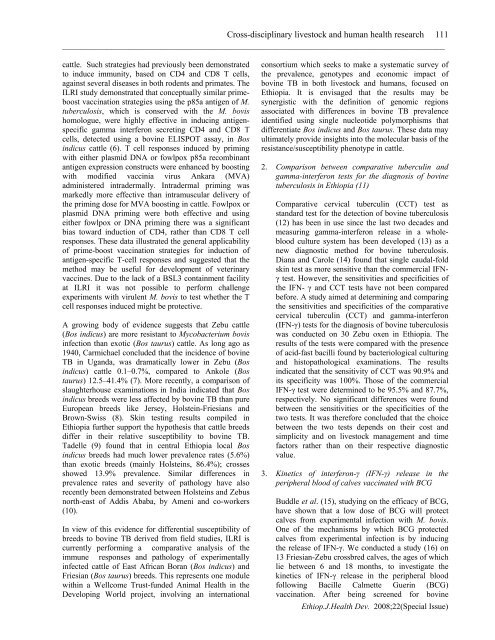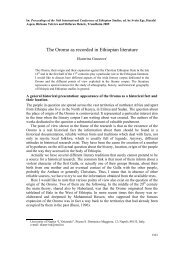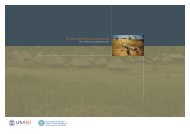You also want an ePaper? Increase the reach of your titles
YUMPU automatically turns print PDFs into web optimized ePapers that Google loves.
Cross-disciplinary livestock and human health research 111<br />
______________________________________________________________________________________<br />
cattle. Such strategies had previously been demonstrated<br />
to induce immunity, based on CD4 and CD8 T cells,<br />
against several diseases in both rodents and primates. The<br />
ILRI study demonstrated that conceptually similar primeboost<br />
vaccination strategies using the p85a antigen of M.<br />
tuberculosis, which is conserved with the M. bovis<br />
homologue, were highly effective in inducing antigenspecific<br />
gamma interferon secreting CD4 and CD8 T<br />
cells, detected using a bovine ELISPOT assay, in Bos<br />
indicus cattle (6). T cell responses induced by priming<br />
with either plasmid DNA or fowlpox p85a recombinant<br />
antigen expression constructs were enhanced by boosting<br />
with modified vaccinia virus Ankara (MVA)<br />
administered intradermally. Intradermal priming was<br />
markedly more effective than intramuscular delivery of<br />
the priming dose for MVA boosting in cattle. Fowlpox or<br />
plasmid DNA priming were both effective and using<br />
either fowlpox or DNA priming there was a significant<br />
bias toward induction of CD4, rather than CD8 T cell<br />
responses. These data illustrated the general applicability<br />
of prime-boost vaccination strategies for induction of<br />
antigen-specific T-cell responses and suggested that the<br />
method may be useful for development of veterinary<br />
vaccines. Due to the lack of a BSL3 containment facility<br />
at ILRI it was not possible to perform challenge<br />
experiments with virulent M. bovis to test whether the T<br />
cell responses induced might be protective.<br />
A growing body of evidence suggests that Zebu cattle<br />
(Bos indicus) are more resistant to Mycobacterium bovis<br />
infection than exotic (Bos taurus) cattle. As long ago as<br />
1940, Carmichael concluded that the incidence of bovine<br />
TB in Uganda, was dramatically lower in Zebu (Bos<br />
indicus) cattle 0.1–0.7%, compared to Ankole (Bos<br />
taurus) 12.5–41.4% (7). More recently, a comparison of<br />
slaughterhouse examinations in India indicated that Bos<br />
indicus breeds were less affected by bovine TB than pure<br />
European breeds like Jersey, Holstein-Friesians and<br />
Brown-Swiss (8). Skin testing results compiled in<br />
Ethiopia further support the hypothesis that cattle breeds<br />
differ in their relative susceptibility to bovine TB.<br />
Tadelle (9) found that in central Ethiopia local Bos<br />
indicus breeds had much lower prevalence rates (5.6%)<br />
than exotic breeds (mainly Holsteins, 86.4%); crosses<br />
showed 13.9% prevalence. Similar differences in<br />
prevalence rates and severity of pathology have also<br />
recently been demonstrated between Holsteins and Zebus<br />
north-east of Addis Ababa, by Ameni and co-workers<br />
(10).<br />
In view of this evidence for differential susceptibility of<br />
breeds to bovine TB derived from field studies, ILRI is<br />
currently performing a comparative analysis of the<br />
immune responses and pathology of experimentally<br />
infected cattle of East African Boran (Bos indicus) and<br />
Friesian (Bos taurus) breeds. This represents one module<br />
within a Wellcome Trust-funded Animal Health in the<br />
Developing World project, involving an international<br />
consortium which seeks to make a systematic survey of<br />
the prevalence, genotypes and economic impact of<br />
bovine TB in both livestock and humans, focused on<br />
Ethiopia. It is envisaged that the results may be<br />
synergistic with the definition of genomic regions<br />
associated with differences in bovine TB prevalence<br />
identified using single nucleotide polymorphisms that<br />
differentiate Bos indicus and Bos taurus. These data may<br />
ultimately provide insights into the molecular basis of the<br />
resistance/susceptibility phenotype in cattle.<br />
2. Comparison between comparative tuberculin and<br />
gamma-interferon tests for the diagnosis of bovine<br />
tuberculosis in Ethiopia (11)<br />
Comparative cervical tuberculin (CCT) test as<br />
standard test for the detection of bovine tuberculosis<br />
(12) has been in use since the last two decades and<br />
measuring gamma-interferon release in a wholeblood<br />
culture system has been developed (13) as a<br />
new diagnostic method for bovine tuberculosis.<br />
Diana and Carole (14) found that single caudal-fold<br />
skin test as more sensitive than the commercial IFNγ<br />
test. However, the sensitivities and specificities of<br />
the IFN- γ and CCT tests have not been compared<br />
before. A study aimed at determining and comparing<br />
the sensitivities and specificities of the comparative<br />
cervical tuberculin (CCT) and gamma-interferon<br />
(IFN-γ) tests for the diagnosis of bovine tuberculosis<br />
was conducted on 30 Zebu oxen in Ethiopia. The<br />
results of the tests were compared with the presence<br />
of acid-fast bacilli found by bacteriological culturing<br />
and histopathological examinations. The results<br />
indicated that the sensitivity of CCT was 90.9% and<br />
its specificity was 100%. Those of the commercial<br />
IFN-γ test were determined to be 95.5% and 87.7%,<br />
respectively. No significant differences were found<br />
between the sensitivities or the specificities of the<br />
two tests. It was therefore concluded that the choice<br />
between the two tests depends on their cost and<br />
simplicity and on livestock management and time<br />
factors rather than on their respective diagnostic<br />
value.<br />
3. Kinetics of interferon-γ (IFN-γ) release in the<br />
peripheral blood of calves vaccinated with BCG<br />
Buddle et al. (15), studying on the efficacy of BCG,<br />
have shown that a low dose of BCG will protect<br />
calves from experimental infection with M. bovis.<br />
One of the mechanisms by which BCG protected<br />
calves from experimental infection is by inducing<br />
the release of IFN-γ. We conducted a study (16) on<br />
13 Friesian-Zebu crossbred calves, the ages of which<br />
lie between 6 and 18 months, to investigate the<br />
kinetics of IFN-γ release in the peripheral blood<br />
following Bacille Calmette Guerin (BCG)<br />
vaccination. After being screened for bovine<br />
Ethiop.J.Health Dev. <strong>2008</strong>;22(Special Issue)







